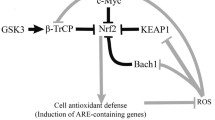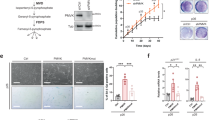Abstract
Cellular senescence is an in vivo and in vitro phenomenon, accompanied by physiological changes including cessation of division and disturbances of organelle structure and function. Review of the literature was undertaken to determine whether there is evidence that whole organism aging and cell senescence share a common initiation pathway. In vivo aged cells of different lineages, including aged T lymphocytes, show high expression of the INK4A-p16 gene. In cell culture when telomeres are shortened past a key length or state, the Arf/Ink gene system (p16/p14 humans, p16/p19 mice) switches on and activates p53, which suppresses further cell division. The p53 gene is a key tumor suppressor and its deletion or mutation allows cancerous growth. The switching on of p53 also causes changes in fatty acid metabolism, especially down-regulation of both fatty acid synthase and stearoyl-CoA (delta-9) desaturase. The co-suppression of these genes together with enhanced uptake of extracellular fatty acids, leads to raised levels of cellular palmitate and induction of either apoptosis or senescence. In senescent cells, the fatty acid composition of the cellular membranes alters and leads to changes in both structure and function of organelles, especially mitochondria. Animal models of accelerated aging exhibit repression of stearoyl-CoA desaturase activity while anti-aging calorie restriction stimulates the same enzyme system. It is concluded that aging in cells and whole organisms share a common initiation pathway and that cellular senescence is protective against cancer. Healthy longevity is likely to be most enhanced by factors that actively suppress excessive cell division.

Similar content being viewed by others
References
Apte UM, Limaye PB, Ramaiah SK, Vaidya VS, Bucci TJ, Warbritton A, Mehendale HM (2002) Upregulated promitogenic signaling via cytokines and growth factors: potential mechanism of robust liver tissue repair in calorie-restricted rats upon toxic challenge. Toxicol Sci 69:448–459
Ayala V, Naudi A, Sanz A, Caro P, Portero-Otin M, Barja G, Pamplona R (2007) Dietary protein restriction decreases oxidative protein damage, peroxidizability index, and mitochondrial complex I content in rat liver. J Gerontol A Biol Sci Med Sci 62:352–360. doi:62/4/352 [pii]
Baker DJ, Perez-Terzic C, Jin F, Pitel K, Niederlander NJ, Jeganathan K, Yamada S, Reyes S, Rowe L, Hiddinga HJ, Eberhardt NL, Terzic A, van Deursen JM (2008) Opposing roles for p16Ink4a and p19Arf in senescence and ageing caused by BubR1 insufficiency. Nat Cell Biol 10:825–836. doi:ncb1744 [pii] 10.1038/ncb1744
Blazquez C, Galve-Roperh I, Guzman M (2000) De novo-synthesized ceramide signals apoptosis in astrocytes via extracellular signal-regulated kinase. FASEB J 14:2315–2322. doi:10.1096/fj.00-0122com 14/14/2315 [pii]
Chen QM, Liu J, Merrett JB (2000) Apoptosis or senescence-like growth arrest: influence of cell-cycle position, p53, p21 and bax in H2O2 response of normal human fibroblasts. Biochem J 347:543–551
Cristofalo VJ, Allen RG, Pignolo RJ, Martin BG, Beck JC (1998) Relationship between donor age and the replicative lifespan of human cells in culture: a reevaluation. Proc Natl Acad Sci U S A 95:10614–10619
D'Erchia AM, Tullo A, Lefkimmiatis K, Saccone C, Sbisa E (2006) The fatty acid synthase gene is a conserved p53 family target from worm to human. Cell Cycle 5:750–758. doi:2622 [pii]
da Costa N, McGillivray C, Bai Q, Wood JD, Evans G, Chang KC (2004) Restriction of dietary energy and protein induces molecular changes in young porcine skeletal muscles. J Nutr 134:2191–2199. doi:134/9/2191 [pii]
Ford JH, Tavendale R (2009) Analysis of fatty acids in early mid-life in fertile women: implications for reproductive decline and other chronic health problems. Am J Hum Biol. doi:10.1002/ajhb.20904
Hardy RW, Meckling-Gill KA, Williford J, Desmond RA, Wei H (2002) Energy restriction reduces long-chain saturated fatty acids associated with plasma lipids in aging male rats. J Nutr 132:3172–3177
Harris CC (1996) Structure and function of the p53 tumor suppressor gene: clues for rational cancer therapeutic strategies. J Natl Cancer Inst 88:1442–1455
Hayflick L (1976) The cell biology of human aging. N Engl J Med 295:1302–1308
Heller TD, Holt PR, Richardson A (1990) Food restriction retards age-related histological changes in rat small intestine. Gastroenterology 98:387–391. doi:S001650859000052X [pii]
Hickson-Bick DL, Sparagna GC, Buja LM, McMillin JB (2002) Palmitate-induced apoptosis in neonatal cardiomyocytes is not dependent on the generation of ROS. Am J Physiol Heart Circ Physiol 282:H656–H664. doi:10.1152/ajpheart.00726.2001
Karlseder J, Smogorzewska A, de Lange T (2002) Senescence induced by altered telomere state, not telomere loss. Science 295:2446–2449. doi:10.1126/science.1069523 295/5564/2446 [pii]
Kolosova NG, Aidagulova SV, Nepomnyashchikh GI, Shabalina IG, Shalbueva NI (2001) Dynamics of structural and functional changes in hepatocyte mitochondria of senescence-accelerated OXYS rats. Bull Exp Biol Med 132:814–819
Krishnamurthy J, Torrice C, Ramsey MR, Kovalev GI, Al-Regaiey K, Su L, Sharpless NE (2004) Ink4a/Arf expression is a biomarker of aging. J Clin Invest 114:1299–1307. doi:10.1172/JCI22475
Kumar VB, Vyas K, Buddhiraju M, Alshaher M, Flood JF, Morley JE (1999) Changes in membrane fatty acids and delta-9 desaturase in senescence accelerated (SAMP8) mouse hippocampus with aging. Life Sci 65:1657–1662. doi:S0024320599004142 [pii]
Liu Y, Sanoff HK, Cho H, Burd CE, Torrice C, Ibrahim JG, Thomas NE, Sharpless NE (2009) Expression of p16(INK4a) in peripheral blood T-cells is a biomarker of human aging. Aging Cell 8:439–448. doi:ACE489 [pii] 10.1111/j.1474-9726.2009.00489.x
Lok E, Scott FW, Mongeau R, Nera EA, Malcolm S, Clayson DB (1990) Calorie restriction and cellular proliferation in various tissues of the female Swiss Webster mouse. Cancer Lett 51:67–73. doi:0304-3835(90)90232-M [pii]
Lowe SW, Sherr CJ (2003) Tumor suppression by Ink4a-Arf: progress and puzzles. Curr Opin Genet Dev 13:77–83. doi:S0959437X02000138 [pii]
Macnamara BG, Farn KT, Mitra AK, Lloyd JK, Fosbrooke AS (1970) Progeria. Case report with long-term studies of serum lipids. Arch Dis Child 45:553–560
Maeda M, Scaglia N, Igal RA (2009) Regulation of fatty acid synthesis and Delta9-desaturation in senescence of human fibroblasts. Life Sci 84:119–124. doi:S0024-3205(08)00470-0 [pii] 10.1016/j.lfs.2008.11.009.
McNamara RK, Liu Y, Jandacek R, Rider T, Tso P (2008) The aging human orbitofrontal cortex: decreasing polyunsaturated fatty acid composition and associated increases in lipogenic gene expression and stearoyl-CoA desaturase activity. Prostaglandins Leukot Essent Fatty Acids 78:293–304. doi:S0952-3278(08)00035-5 [pii] 10.1016/j.plefa.2008.04.001
Morley JE (2002) The SAMP8 mouse: a model of Alzheimer disease? Biogerontology 3:57–60
Murthy VK, Oredipe OA, Stiles MR, Shipp JC (1986) Increased fatty acid uptake, a factor in increased hepatic triacylglycerol synthesis in aging rats. Mech Ageing Dev 37:49–54. doi:0047-6374(86)90117-X [pii]
Nakamura MT, Nara TY (2004) Structure, function, and dietary regulation of delta6, delta5, and delta9 desaturases. Annu Rev Nutr 24:345–376. doi:10.1146/annurev.nutr.24.121803.063211
Oren M (2003) Decision making by p53: life, death and cancer. Cell Death Differ 10:431–442. doi:10.1038/sj.cdd.4401183 4401183 [pii]
Paumen MB, Ishida Y, Muramatsu M, Yamamoto M, Honjo T (1997) Inhibition of carnitine palmitoyltransferase I augments sphingolipid synthesis and palmitate-induced apoptosis. J Biol Chem 272:3324–3329
Planey SL, Keay SK, Zhang CO, Zacharias DA (2009) Palmitoylation of cytoskeleton associated protein 4 by DHHC2 regulates antiproliferative factor-mediated signaling. Mol Biol Cell 20:1454–1463. doi:E08-08-0849 [pii] 10.1091/mbc.E08-08-0849
Richieri GV, Kleinfeld AM (1995) Unbound free fatty acid levels in human serum. J Lipid Res 36:229–240
Shay JW, Wright WE (2001) Aging. When do telomeres matter? Science 291:839–840
Shimabukuro M, Zhou YT, Levi M, Unger RH (1998) Fatty acid-induced beta cell apoptosis: a link between obesity and diabetes. Proc Natl Acad Sci U S A 95:2498–2502
Smith S (1994) The animal fatty acid synthase: one gene, one polypeptide, seven enzymes. FASEB J 8:1248–1259
Smogorzewska A, de Lange T (2002) Different telomere damage signaling pathways in human and mouse cells. EMBO J 21:4338–4348
Soussi T (2000) p53 Antibodies in the sera of patients with various types of cancer: a review. Cancer Res 60:1777–1788
Swagell CD, Henly DC, Morris CP (2005) Expression analysis of a human hepatic cell line in response to palmitate. Biochem Biophys Res Commun 328:432–441. doi:S0006-291X(05)00019-7 [pii] 10.1016/j.bbrc.2004.12.188
Takai H, Smogorzewska A, de Lange T (2003) DNA damage foci at dysfunctional telomeres. Curr Biol 13:1549–1556. doi:S0960982203005426 [pii]
Tang DG, La E, Kern J, Kehrer JP (2002) Fatty acid oxidation and signaling in apoptosis. Biol Chem 383:425–442. doi:10.1515/BC.2002.046
Ulloth JE, Casiano CA, De Leon M (2003) Palmitic and stearic fatty acids induce caspase-dependent and -independent cell death in nerve growth factor differentiated PC12 cells. J Neurochem 84:655–668. doi:1571 [pii]
Volpe JJ, Vagelos PR (1976) Mechanisms and regulation of biosynthesis of saturated fatty acids. Physiol Rev 56:339–417
Wagner W, Bork S, Horn P, Krunic D, Walenda T, Diehlmann A, Benes V, Blake J, Huber FX, Eckstein V, Boukamp P, Ho AD (2009) Aging and replicative senescence have related effects on human stem and progenitor cells. PLoS ONE 4:e5846. doi:10.1371/journal.pone.0005846
Welters HJ, Diakogiannaki E, Mordue JM, Tadayyon M, Smith SA, Morgan NG (2006) Differential protective effects of palmitoleic acid and cAMP on caspase activation and cell viability in pancreatic beta-cells exposed to palmitate. Apoptosis 11:1231–1238. doi:10.1007/s10495-006-7450-7
Willcox DC, Willcox BJ, Todoriki H, Curb JD, Suzuki M (2006) Caloric restriction and human longevity: what can we learn from the Okinawans? Biogerontology 7:173–177. doi:10.1007/s10522-006-9008-z
Witte AV, Fobker M, Gellner R, Knecht S, Floel A (2009) Caloric restriction improves memory in elderly humans. Proc Natl Acad Sci U S A 106:1255–1260. doi:0808587106 [pii] 10.1073/pnas.0808587106
Yosefy C, Viskoper JR, Laszt A, Priluk R, Guita E, Varon D, Illan Z, Berry EM, Savion N, Adan Y, Lugassy G, Schneider R, Raz A (1999) The effect of fish oil on hypertension, plasma lipids and hemostasis in hypertensive, obese, dyslipidemic patients with and without diabetes mellitus. Prostaglandins Leukot Essent Fatty Acids 61:83–87. doi:S0952327899900753 [pii]
Author information
Authors and Affiliations
Corresponding author
About this article
Cite this article
Ford, J.H. Saturated fatty acid metabolism is key link between cell division, cancer, and senescence in cellular and whole organism aging. AGE 32, 231–237 (2010). https://doi.org/10.1007/s11357-009-9128-x
Received:
Accepted:
Published:
Issue Date:
DOI: https://doi.org/10.1007/s11357-009-9128-x




